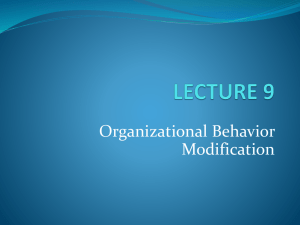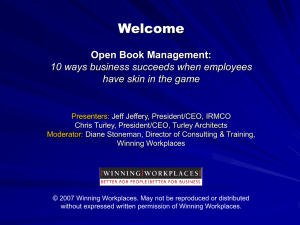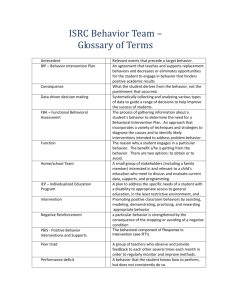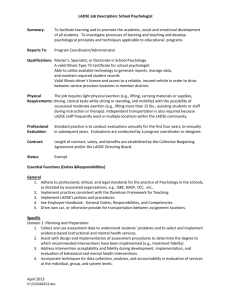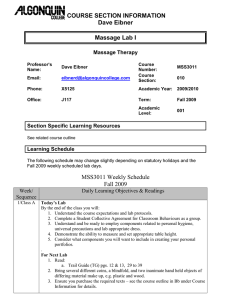- Cambridge Center for Behavioral Studies
advertisement
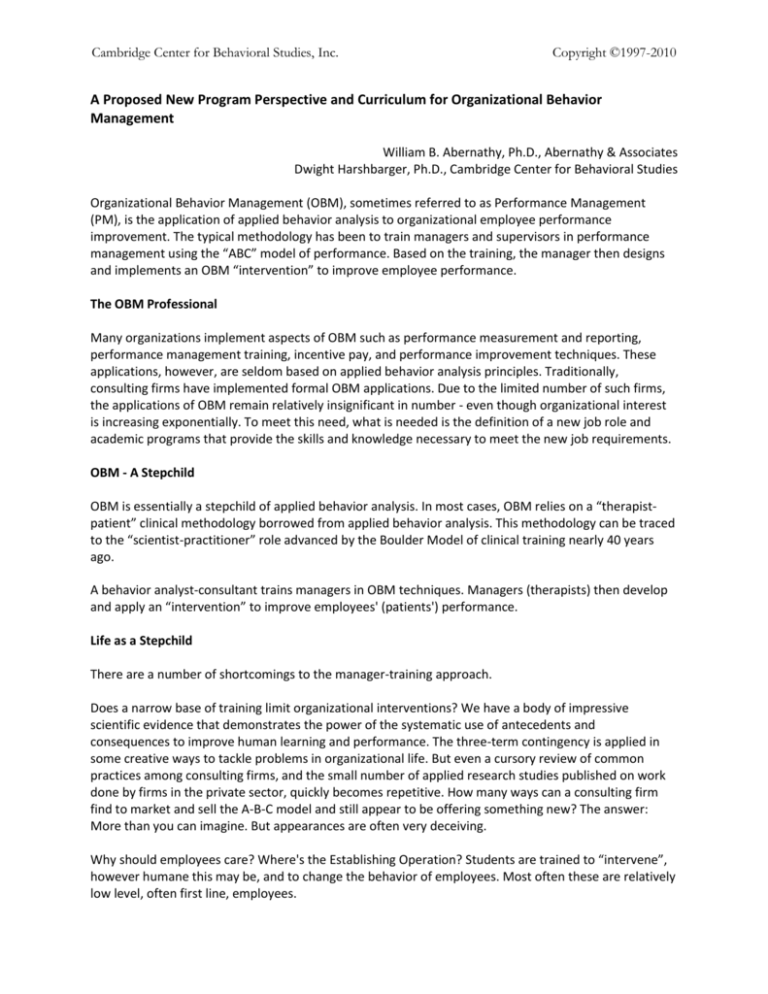
Cambridge Center for Behavioral Studies, Inc. Copyright ©1997-2010 A Proposed New Program Perspective and Curriculum for Organizational Behavior Management William B. Abernathy, Ph.D., Abernathy & Associates Dwight Harshbarger, Ph.D., Cambridge Center for Behavioral Studies Organizational Behavior Management (OBM), sometimes referred to as Performance Management (PM), is the application of applied behavior analysis to organizational employee performance improvement. The typical methodology has been to train managers and supervisors in performance management using the “ABC” model of performance. Based on the training, the manager then designs and implements an OBM “intervention” to improve employee performance. The OBM Professional Many organizations implement aspects of OBM such as performance measurement and reporting, performance management training, incentive pay, and performance improvement techniques. These applications, however, are seldom based on applied behavior analysis principles. Traditionally, consulting firms have implemented formal OBM applications. Due to the limited number of such firms, the applications of OBM remain relatively insignificant in number - even though organizational interest is increasing exponentially. To meet this need, what is needed is the definition of a new job role and academic programs that provide the skills and knowledge necessary to meet the new job requirements. OBM - A Stepchild OBM is essentially a stepchild of applied behavior analysis. In most cases, OBM relies on a “therapistpatient” clinical methodology borrowed from applied behavior analysis. This methodology can be traced to the “scientist-practitioner” role advanced by the Boulder Model of clinical training nearly 40 years ago. A behavior analyst-consultant trains managers in OBM techniques. Managers (therapists) then develop and apply an “intervention” to improve employees' (patients') performance. Life as a Stepchild There are a number of shortcomings to the manager-training approach. Does a narrow base of training limit organizational interventions? We have a body of impressive scientific evidence that demonstrates the power of the systematic use of antecedents and consequences to improve human learning and performance. The three-term contingency is applied in some creative ways to tackle problems in organizational life. But even a cursory review of common practices among consulting firms, and the small number of applied research studies published on work done by firms in the private sector, quickly becomes repetitive. How many ways can a consulting firm find to market and sell the A-B-C model and still appear to be offering something new? The answer: More than you can imagine. But appearances are often very deceiving. Why should employees care? Where's the Establishing Operation? Students are trained to “intervene”, however humane this may be, and to change the behavior of employees. Most often these are relatively low level, often first line, employees. Cambridge Center for Behavioral Studies, Inc. Copyright ©1997-2010 Our training programs rarely lead to our students asking a very tough question: Short of avoiding punishment, why should employees care about performance improvement? Or, a more far reaching question, How do employees, supervisors and managers near the base of an organizational pyramid, people at or near the first line, share in an organization's profit performance? The latter question can be answered through adopting incentive and bonus systems, such as gain sharing, and compensation consultants will help do that. But rarely are these systems extended to the “little people” whose day to day performance is critical to the success of a company. Lincoln Electric is the exception, not the rule. Where's the system? Rarely do performance interventions pinpoint behaviors and results at every level of the organization. And systematically and quantitatively link performance and profitability. Many behavioral consulting firms talk about this, but few do it. Among those firms who purportedly do it, explicit descriptions of their proprietary, trademarked and copyrighted methods, and full disclosure of outcome data, are not provided in publications. In the absence of working models of systems operations, and training to guide students in how to use those models, the absence of systems intervention in training programs, where consulting firms practice, should come as no surprise. Why do behavior-based interventions have a short life? And often fail? Lasting behavioral interventions in organizations are noteworthy. The fact that various consulting firms maintain long term relationships with clients does not necessarily mean that their behavior-based interventions are effective. Client relationships are based on many variables. Evidence of programmatic outcomes is only one of them. The truth is that most behavior-based organizational interventions have a short life. Why? First, in most organizations a very human process weakens the often-dramatic successes of behaviorbased performance engineering. Once a system is built and managers trained to work positively within it, the resources needed to insure the continued development and updating of the system are sometimes overlooked, and sometimes cut in moves to reduce costs. Other changes occur. Key people are promoted or transferred and others may leave for jobs elsewhere. New managers may not receive the training they need to become proficient in keeping the system working effectively. As all this happens, small but important tasks get overlooked. The system, once welcomed, becomes a chore. Competing contingencies, many with long histories, come into play. Managers revert to old ways of doing things. Second, and most importantly, the performance of first line employees and supervisors, who typically are the principal target of behavioral interventions, is not linked to a company's financial success. In most organizations, company financial performance has no impact on first line people. Good work or marginal work, fast or slow, employees still receive a wage or salary. And bonuses and incentives are awarded to more senior people on the basis of outcomes over which first line employees have little or no direct control, but influence a lot. The late Glenn Latham often said that we work too hard trying to control the behavior of others. Let consequences do the managing for you, Glenn advised. But how do we do this in organizations, in systems? How do we best train our students to make a difference in a system's performance? Is there a flaw in the training model? A flaw is that it fails to address many critical organizational “system” contingencies. In the real world of organizational life, there are complex and interrelated multiple performances, hierarchical interactions and interactions across jobs and departments, Cambridge Center for Behavioral Studies, Inc. Copyright ©1997-2010 competing reinforcement contingencies and many other critical behavioral features in the landscape. Put simply, the model “can't see the forest for the trees”. Performance Systems Behavior occurs in an organizational context, a context in which there are systems of contingencies that operate at different levels of performance. These contingencies have different, potentially enhancing or conflicting, effects on the performance of individuals and work groups. While it is commonplace to acknowledge the presence of these systems, bringing them into an analytic framework is important, but not common. Making such a framework part of a formal training program, is even more important, and perhaps more rare. There have been past attempts to do this; e.g., Brethower (1972), Harshbarger and Maley (1974), Gilbert (1978), Rummler and Brache (1991), and Abernathy (1996, 2000). But, none of them has led to a training model that is both behavioral and systems based. Training programs often to the importance of a systems perspective, but do not develop the technology to bring this perspective to life as a measurable set of outcomes in training skills. We feel this can be done. A first step is to focus on the kind of person we plan to train, and the potential value such a person brings to an organization. The Performance Systems Analyst The term “Organizational Behavior Management” does not adequately describe the proposed profession. It is not the dependent variable, behavior that is managed by the analyst. Rather, organizational contingencies, the independent variables, are modified to produce and sustain improvements in employee performances. That is, the performance system is analyzed and managed not the target behaviors. Optimal and sustained performance improvements within an organization require the redesign of the total performance system - not limited one or two-dimensional interventions as have been common in OBM. We may improve the typing behavior of a data entry clerk with direct prompting, feedback, and social reinforcement. If a consultant implements this process, the improvement is often unsustainable once the consultant departs. If a manager is trained to implement these procedures, the process will survive only as long as the manager remains, and only if the manager is reinforced for maintaining it. What we fail to address are the wider organizational contingencies. Did the recruitment and selection process provide the right individual for the job? Was the individual effectively trained? Are the equipment and work methods efficient? Is the workflow efficient? Do the staffing and work distribution models ensure adequate work input? Is performance feedback supplied to the performer on a permanent basis? Do the organization's annual performance review, merit pay increases, promotions, and incentive plans support key performance over the long term? For example, one of the job positions for which a performance improvement plan was developed was a bank's item processor. A common production cycle was discovered in each operator's performance. Production was high on Mondays and Fridays and lower in the middle of the week. It was speculated that the weekend served as an establishing operation or reinforcer, and so on. In fact the processors simply had more work input available on Monday and Friday than in the middle of the week. The OBM analyst erroneously focused on the behavior rather than the environment. Cambridge Center for Behavioral Studies, Inc. Copyright ©1997-2010 The Performance System Analysts' Skills Performance Measurement. The foundation of a performance system (or any technology) is an effective measurement system. The PSA should be familiar with financial measures in general and be able to design, manage and evaluate performance measures for sales, expense control, productivity, cash flow, regulatory compliance, customer satisfaction, and projects. Performance Pay. The PSA should be familiar with conventional compensation and promotion practices and be able to redesign or design, evaluate, and manage more effective reinforcement contingencies. Performance Improvement. The PSA should be able to advise managers in the application of behavior management principles within the organization. He or she should be able to analyze complex performance measures to pinpoint improvement opportunities and the root causes of performance problems. In addition to conventional OBM performance improvement techniques, the PSA should be familiar with a range of improvement strategies including instructional design, work forecasting, staffing, cross-utilization, work distribution, process improvements, and work flow improvements. Performance Systems Management. The PSA should understand and be able to administer and analyze complex, relational databases that manage performance reporting and incentive payouts. The PSA should be skilled in analytical techniques that examine time series and complex interactions across performance measures. The PSA should be familiar with the conventional Human Resources functions of selection, training, evaluation, promotion, and compensation. The PSA would have the skills to integrate these functions with the performance system measures, improvement strategies, and reinforcement contingencies. Finally, the PSA should be able to execute, effective communication and organizational change strategies. Conclusions and Recommendations OBM should be much more than the application of clinical ABA practices in organizations. The term Performance Systems Analyst may be more descriptive and marketable. The new PSA curriculum will focus on system interventions rather than one-on-one interventions between consultant and manager, or manager and worker. Universities need to train and market true OBM professionals to organizations. The training should focus on performance systems management rather than the traditional clinical approach. It should include coursework in finance and human resources and, perhaps, systems theory. The curriculum should be offered to traditional OBM students, staff within organizations, and as an optional course sequence in business school human resources MBA programs. References Abernathy, W.B. (1996). The Sin of wages. Memphis, TN: PerfSys Press. Abernathy, W.B. (2000). Managing without supervising: Creating an organization-wide performance system. Memphis, TN: PerfSys Press. Brethower, D. M. (1972). Behavioral analysis in business and industry: A total performance system. Kalamozoo, MI: Behaviordelia. Cambridge Center for Behavioral Studies, Inc. Copyright ©1997-2010 Gilbert, T. (1978). Human competence: Engineering worthy performance. New York: McGraw-Hill Book Company. Harshbarger, D.& Maley, R. (1974) Behavior analysis and systems analysis. Kalamazoo, MI: Behaviordelia. Latham, G. (1990). The power of positive parenting. Logan, Utah: P & T ink. Rummler, G.A. & Brache, A.P. (1991). Improving performance: How to manage the white spaces on the organizational chart. San Francisco: Jossey-Bass.
